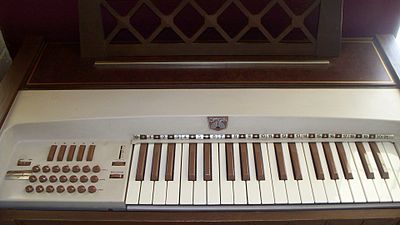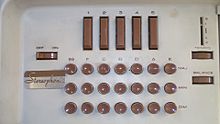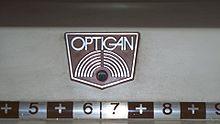- Optigan
-
The Optigan (a portmanteau of Optical Organ) was an electronic keyboard instrument designed for the consumer market. The name stems from the instrument's reliance on pre-recorded optical soundtracks to reproduce sound. Later versions (built under license and aimed at the professional market) were sold under the name Orchestron.[1]
The immediate predecessors of the Optigan were the "Welte Lichtton-Orgel" of 1936 and the Lumigraph of 1950.
Contents
Production history
Engineering work on the project began in 1968 and the first patents issued in 1970. The Optigan was released in 1971 by Optigan Corporation, a subsidiary of toy manufacturer Mattel, Incorporated of El Segundo, California with the manufacturing plant located nearby in Compton, California. All rights to the Optigan, the disc format, and all previous discs were sold in 1973 to Miner Industries of New York, an organ manufacturer who formed a subsidiary, Opsonar, to produce it. Miner had record sales for a time, in part due to Opsonar. However, sales declined shortly thereafter and production of the Optigan and its discs ceased in 1976.
Appearance and construction
The Optigan looked like a scaled-down version of the electronic organs of the day. The various cabinet designs and their matching benches were simulated wood made out of a molded plastic the manufacturer dubbed "Temperite" and finished with matching speaker grille cloth and occasionally reverb units inside the unit. A mechanical reverb unit and cabinetry with genuine wood veneer were available as extra-cost options; the switch for the reverb on units so equipped is located below the power switch. Non-reverb equipped Optigans feature a metal plate which reads "Stereophonic" in raised relief and which hides the unused opening. Reverb-equipped units had a slightly different plate which read "REVERB Stereophonic" affixed immediately to the left of the rocker switches and above the power switch. According to optigan.com, two piano bar prototypes were produced. The Optigan played in stereo through two solid state amplifiers with the right-hand keyboard assigned to the instrument's right channel and the chords and effects assigned to the left.
The optical disc format
The Optigan's playback system functioned much like the storage and reading of an optical soundtrack as was used in motion pictures, using a light bulb to energize a photoelectric cell on the opposite side of spinning, 12" diameter clear plastic film discs (officially referred to as "Program Discs") encoded with fifty-seven concentric optical tracks. The system then translated the analog waveforms on the disc to an audio signal. A flip-down door beneath the keyboard allowed access to the disc's loading area to the left of the unit and a disc storage area to the right. Program discs were loaded by simply sliding them onto the felt-covered platform; a V-shaped notch on the front of the panel aided in alignment. When power was applied and the front cover closed, a spindle engaged the center hole of the disc and a motor-driven idler wheel spun the disc on the spindle. The power switch itself was mechanically linked to the disc's drive system; lowering the front panel dropped the spindle and disconnected power to the instrument, allowing the program discs to be changed without the need to fully power down. A broad, flat, white plastic cleaning tool with a purple, simulated velvet cleaning surface was supplied with each Optigan to allow periodic cleaning of the photoelectric cell, located near the rear of the instrument.
Thirty-seven tracks were sustained or repeatedly percussive notes in the timbre of a particular instrument and were played through a standard three-octave piano-style keyboard with the right hand; twenty-one were of a live band or soloist playing chords in different keys arranged per the circle of fifths, specifically B-flat, F, C, G, D, A and E major, minor, and diminished and were played with the left hand in much the style of a chord organ or accordion. The remaining five were assigned to rocker switches above the chord buttons and featured (depending on the disc in question) percussion, sound effects, introductions, vamps, and endings synchronized with the chord buttons. Pushing upward on the rocker switches locked them in place for use with percussion; pushing downward allowed momentary use for vamps, introductions and endings.
 Cover of the beginner's music book shipped with each new Optigan. Despite the mention on the cover, no disc with the sound of a sitar was ever offered
Cover of the beginner's music book shipped with each new Optigan. Despite the mention on the cover, no disc with the sound of a sitar was ever offered
Not all of the chord buttons had their own track assignments, the result being only fifty-seven sounds on sixty-three buttons, keys and switches. There was also an optical metronome incorporated into the discs which showed as a red flashing light for the downbeat and white for the upbeats inside the Optigan badge above the keyboard. The advantages of this unique optical playback system were that the Optigan's range of timbres was infinitely expandable and that there was no limit on the duration of a note as there was on the Optigan's professional-grade counterpart, the magnetic tape-based Mellotron. The disadvantage was that notes could have neither attack nor decay, as the tracks had no specific beginning or end.
The "Starter Set" sold with the Optigan contained discs with fairly self-explanatory titles: "Big Organ & Drums", "Pop Piano Plus Guitar", "Latin Fever", and "Guitar in 3/4 Time." More modern styles were represented by titles such as "Movin'!," which was a rhythm and blues disc and "Hear and Now," with a sound clearly based on the hit single "Sweet Seasons" by Carole King (and cover art evocative of that of her Tapestry album). Other discs were marketed individually and packaged much like long-playing phonograph records. These individual titles were also bundled in much the same way as the "Starter Set" and sold as six-disc "Entertainment Folios." Some discs were available only as part of a two-disc "Style Pak" with titles such as "The Joyous Sounds of Christmas", "Country Style Pak.", "Polka" and "Songs Of Praise" - these last two being produced towards the end of production and in very low quantities. Music books of various styles and even arrangements intended for individual disks were also available and sometimes packaged with the different bundles.
The initial run of musical tracks were recorded by Southern California studio musicians in Hollywood and Torrance. However, a musicians' union strike meant that some of the later discs were recorded in Germany. One disc is of particular note. The instrumental tracks for "Bluegrass Banjo" were recorded by members of the Nitty Gritty Dirt Band. The Vox Humana disc keyboard sound was used for the "Vocal Choir" Orchestron disc.
For the benefit of those unable to read music, the notes in the books were numbered in correspondence to a numbered and color-coded foil strip above the keyboard. The Optigan's songbooks were written and arranged by Optigan Corporation's music director, Johnny Largo. Largo, an accordionist and session musician, was a contemporary of Johnny Marks, a composer best known for his popular mid-20th century Christmas melodies. As such, many of the songs in the Christmas books were Marks compositions.
Problems
Despite its use of recordings of actual musical instruments in lieu of internally generated sounds, the Optigan suffered from poor tonal quality due not only to the bandwidth limitations of its optical system but its mechanical system as well. The Optigan concept was really similar to that of the Mellotron (early sampling technology) but while the Mellotron used magnetic tape, the Optigan borrowed its technology from motion picture optical soundtrack technology and its amplitude modulated format.
The disc could be sped up or slowed down via a thumbwheel next to the chord buttons to cause a corresponding change in tempo and pitch; however, faster speeds tended to roll off the lower frequencies, slower speeds rolled off the highs and moderate to slow tempo lent a slightly muddy quality overall. Natural imperfections on the celluloid discs as well as dust and dirt came through as scratches, clicks and pops, much like a worn phonograph record. Furthermore, the pitch change brought on by the tempo adjustment made session work with live musicians a difficult proposition, especially since the pitch varied greatly from disc to disc.
Even though the technology of the day was more than sophisticated enough to avoid them, there were numerous mechanical problems with the disc's motor drive due to its having been engineered to be as affordable as possible. Changes in environment which had a physical effect on the photocells frequently led to crosstalk between tracks. One common example involves the F at the upper end of the keyboard; press this key, step on the volume control pedal and the C-diminished/A-diminished chord can often be heard in the background.
These same diminished chords intentionally found their way onto the row of major chords. And as pointed out earlier in this article, not all of the chord buttons had their own track assignments. In a very unusual move, A-major utilizes the same soundtrack as B-flat-diminished, G-diminished, and E-diminished while E-major shares space with F-diminished and D-diminished, thereby making it impossible to play in the keys of A or E, at least with left-hand accompaniment. Apparently, this was done to save space on the disc, further explaining the lack of dominant seventh chords or any chords in the keys of E-flat, A-flat, D-flat, B and F-sharp.
 Cover of the 1972 Everything Is Beautiful songbook. As the name suggests, it was filled with arrangements of the soft popular music of the day.
Cover of the 1972 Everything Is Beautiful songbook. As the name suggests, it was filled with arrangements of the soft popular music of the day.
Since the instrument was aimed at amateur players, the majority of the songs in the Optigan's music books are written in the much simpler keys of F, C and G. The Optigan certainly had its share of detractors, then as now. Yet it provided an entertaining and educational introduction to the world of music and likely sparked interest in a generation of budding musicians and composers.
Vako Orchestron
Further information: OrchestronVako Synthesizers Incorporated, founded by electronic instrument pioneer David Van Koevering, and who built licensed versions of the Optigan under the name Orchestron in the mid 1970s. Intended for professional use as an alternative to the Mellotron, the Orchestron featured improved recorded sounds over the Optigan. Some models included sequencers and synthesizers. While the same fidelity limitations of the Optigan applied to the Orchestron, these instruments were built to be more reliable and were used successfully in commercial recordings.
Use in the music industry
Regardless of its limitations and its problems with pitch, many notable musicians have used the Optigan. Among them: Trace, Steve Hackett, Third Eye Blind, The Clash, Elvis Costello, Jon Brion, Blur, Marco Benevento, Fiona Apple, Kraftwerk (Orchestron), Money Mark, Ani DiFranco, Michael Penn, Steve Fisk, Tom Waits, Nan Vernon, Hala Strana, TISM, The Real Tuesday Weld, Mark Mothersbaugh of Devo—who mixed in parts of the "Banjo Sing-Along" disc on a later remix of Devo's 1981 single, "Beautiful World."
One of the earliest recordings that used the Optigan was an album by European dance music pioneer Alan Steward. On his 1970s album release "Just Listen", Alan made extensive use of the Optigan. Six out of the nine tracks on the album including the title track "Just Listen" feature the Optigan. Alan also made extensive use of the "breakbeats" and the samples of the Hammond B3 organ that were part of the backing tracks found on many of the soul and R&B oriented Optigan discs. The European distributor of the Optigan used Alan Steward's album for promotion and in-store demos.
Steve Hackett has also made frequent use of the Optigan. Hackett's 1980 album, Defector, features an unusual number called "Sentimental Institution," recorded with a solo Optigan spinning the "Big Band Beat" disc behind his own vocals. Hackett made use of all five of that disc's vamps and its ending; that particular disc featured no percussion tracks. His 2003 release, To Watch the Storms, features sonically expanded samples of the Opsonar "Champagne Music" disc on the track, "Circus of Becoming." Also of considerable note is the band Optiganally Yours, featuring keyboardist Pea Hix; they base their original compositions around the Optigan and employ it and similar keyboard instruments on virtually all of their recordings. Hix is also the founder and webmaster of Optigan.com, a major source of information used in this article.
In the late 90's Optigan , Orchestron and Talentmaker samples were released as software sounds. This made the sounds of both instruments much more accessible to musicians despite Optigans being relatively easier to find in the USA. An Optigan sample was used on an episode of the Cartoon Network series, Foster's Home for Imaginary Friends, first airing on October 22, 2004. In it, a mirror image of the character Bloo played sped-up samplings of the vamps and endings of the "Dixieland Strut" disc through a horn which appeared on his body. Another sample was used in an episode of Freaks and Geeks, as the soundtrack of an unseen porn film.
On the album White Chalk by PJ Harvey, an Optigan is played by Eric Drew Feldman. Harvey also wrote much of her Let England Shake album on an Optogan. She also plays it on several tracks.
Steve Adey plays an Optigan on the song I See a Darkness from his debut LP All Things Real.
Marilyn Manson plays the Optigan on the song Target Audience (Narcissus Narcosis) from the album Holy Wood (In the Shadow of the Valley of Death) released in 2001.
AK-Momo uses this instrument prominently on Return to N.Y. The album was recorded using only Optigans, Orchestrons and Mellotrons. Swedish producer Mattias Olsson has since the late 90's recorded several albums that features the Orchestron and Optigan prominently.
American producer Brian Coombes has used the Optigan on releases by singer/songwriter Christian Cuff (Silo and Chalkboard), singer/songwriter Will Kindler (Trifles for Queen Jane), and many other artists.
An Optigan sample is used on the track "Eat Yourself," by Goldfrapp. The same sample was featured on Lily Allen's 2009 release "It's Not Me, It's You," on the track "Chinese." Allen also featured the Optigan sound in two other tracks, "Not Fair" & "He Wasn't There".
Musician Jon Brion composed the soundtrack for the movie Eternal Sunshine of the Spotless Mind (directed by Michel Gondry), using the 'guitar' from a Talentmaker. "It's funny because you were talking about my grandfather inventing (sic) that keyboard," begins Gondry. "Jon has some old keyboards. My father, who is the son-in-law of my grandfather, took over his keyboard shop and he started to sell electronic synthesizers and organs and he had this very weird synthesizer called The Talentmaker. And I hadn't heard or seen one in 30 years. And when I went to see Jon he had this. So when you hear this very sad guitar that we use a lot [in the film,] that's [The Talentmaker]. So you had the nostalgia of my grandfather's shop." [2]
The Optigan sounds were the basis of many tracks on the 2010 Crash Test Dummies album Oooh La La.
A filtered sample of the C-major and F-major chords on the "Easy Does It With Vibes" disc opens a 2010 national television commercial in the United States for online business card printer Vistaprint.com.[3]
The Optigan and the Orchestron also appear in the soundtrack of the 2010 Canadian film Primordial Ties.
See also
References
- Peter Donhauser, Elektrische Klangmaschinen, Boehlau Wien 2007
- ^ Brend, Mark (2005). Strange sounds: offbeat instruments and sonic experiments in pop. Hal Leonard. pp. 104. ISBN 9780879308551. http://books.google.com/books?id=m6KRDxYOp4UC&pg=PT107.
- ^ Spence D. (2004-03-18). "Michel Gondry Talks Music". IGN Entertainment, Inc.. http://music.ign.com/articles/500/500086p1.html. Retrieved 2010-01-26.
- ^ http://www.youtube.com/watch?v=OinrnIwu-uk Example of the Vistaprint commercial at Youtube.com
External links
- "Grooving to the Sound of an Optigan" from NPR.org.
- From Roth Händle Studio:
- Optigan.com - Resource for learning about the Optigan, Orchestron, and the similar Chilton Talentmaker.
- The 'Optigan' and 'Orchestron' at Obsolete.com - A page on the history of the Optigan and a word about the Orchestron
Categories:- Electric and electronic keyboard instruments
Wikimedia Foundation. 2010.



